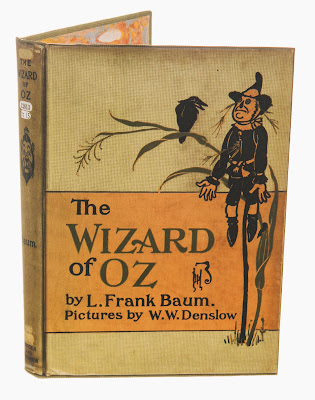 | |||
| Maitland-Smith Aged Regency Finished Mahogany And Lacquer Occasional Table, Leather Faux Book Drawers |
***
 |
| at Marché aux Puces de Saint-Ouen, Paris |
The faux books were not blank. Even though the titles were generally illegible, three of them read MUSEE DE VERSAILLES(?) 18XX-18XX and one of them read XXXXX DE MAISON. The cabinet was probably made at the turn of the century, possibly commissioned by a middle class Parisian who wished to be seen as the sort of person who might have offered you a glass of fashionable absinthe from the cabinet to complement an erudite conversation in a backdrop of books. After all, in iconographical tradition, book is a symbol of power and knowledge.
Faux books are a 19th-century phenomenon, unsurprisingly: born in the century of emerging optical spectacles, curiosity cabinets and all things magical.
Faux books are an Edwardian novelty. Often made of fine jewel-toned leathers with Moroccan leather binding and gold tooling, they usually filled library or study shelves in the homes of the well-to-do. When financial difficulties arose, the faux books were sold to help recoup losses. Cabinetmakers and designers quickly realized the potential in recycling these books-by-the-yard for their decorative and prestige value. Maitland-Smith, the first to incorporate the book motif into modern-day furniture, adheres to many of the norms of library binding in this coffee table and its other book-related items. (Architectural Digest, Volume 61, p 212.)Then there are faux libraries. Many faux libraries might be pointless (library interior in a restaurant?) and/or vain, however British Museum has something different - an entire The Kings Library, Age of Enlightenment exhibition room is composed of replica book spines, produced by FAUX BOOKS: they created exact replica book spines so that genuine books could be placed in environmentally controlled storage.
Maitland-Smith Stacked books coffee table with drawers.
The newest addition to fake books are, of course, the reading tablet covers, which copy the aesthetics of codex books - sometimes even graphics and library stickers - to imitate the real covers.
 |
| The British Library e-book covers. |
 |
| Run For Cover PVC e-book covers. |
Like that 19th century Parisian, 21st century faux book e-reader-cover owners wish to be seen as the sort of people who own and read books.
***
[Egidija]
References:
FAUX BOOKS: http://www.fauxbooks.co.uk/faux-books/
Architectural Digest, Volume 61, p 212.



No comments:
Post a Comment